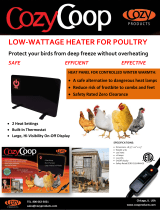
•
Wrench with relevant metric sockets (7–17 mm/
0.28–0.67 in).
•
Wrench extensions.
•
Torx drives (T25 and T50).
•
Sheet metal punch for conduits or cable glands.
•
I-beam and hooks to lift the weight of the drive.
Refer to chapter 3.2 Power Ratings, Weight, and
Dimensions.
•
Crane or other lifting aid to place the drive onto
pedestal and into position.
4.3 Storage
Store the drive in a dry location. Keep the equipment
sealed in its packaging until installation. Refer to
chapter 10.4 Ambient Conditions for recommended ambient
temperature.
Periodic forming (capacitor charging) is not necessary
during storage unless storage exceeds 12 months.
4.4 Operating Environment
NOTICE
In environments with airborne liquids, particles, or
corrosive gases, ensure that the IP/type rating of the
equipment matches the installation environment. Failure
to meet requirements for ambient conditions can reduce
the lifetime of the drive. Ensure that requirements for
humidity, temperature, and altitude are met.
Voltage [V] Altitude restrictions
200–240 At altitudes above 3000 m (9842 ft), contact
Danfoss regarding PELV.
380–480 At altitudes above 3000 m (9842 ft), contact
Danfoss regarding PELV.
525–690 At altitudes above 2000 m (6562 ft), contact
Danfoss regarding PELV.
Table 4.1 Installation at High Altitudes
For detailed ambient conditions specications, refer to
chapter 10.4 Ambient Conditions.
NOTICE
CONDENSATION
Moisture can condense on the electronic components
and cause short circuits. Avoid installation in areas
subject to frost. Install an optional space heater when
the drive is colder than the ambient air. Operating in
standby mode reduces the risk of condensation as long
as the power dissipation keeps the circuitry free of
moisture.
NOTICE
EXTREME AMBIENT CONDITIONS
Hot or cold temperatures compromise unit performance
and longevity.
•
Do not operate in environments where the
ambient temperature exceeds 55 °C (131 °F).
•
The drive can operate at temperatures down to
-10 °C (14 °F). However, proper operation at
rated load is only guaranteed at 0 °C (32 °F) or
higher.
•
If temperature exceeds ambient temperature
limits, extra air conditioning of the cabinet or
installation site is required.
4.4.1 Gases
Aggressive gases, such as hydrogen sulde, chlorine, or
ammonia can damage the electrical and mechanical
components. The unit uses conformal-coated circuit boards
to reduce the
eects of aggressive gases. For conformal-
coating class specications and ratings, see
chapter 10.4 Ambient Conditions.
4.4.2 Dust
When installing the drive in dusty environments, pay
attention to the following:
Periodic maintenance
When dust accumulates on electronic components, it acts
as a layer of insulation. This layer reduces the cooling
capacity of the components, and the components become
warmer. The hotter environment decreases the life of the
electronic components.
Keep the heat sink and fans free from dust buildup. For
more service and maintenance information, refer to
chapter 9 Maintenance, Diagnostics, and Troubleshooting.
Cooling fans
Fans provide airow to cool the drive. When fans are
exposed to dusty environments, the dust can damage the
fan bearings and cause premature fan failure. Also, dust
can accumulate on fan blades causing an imbalance which
prevents the fans from properly cooling the unit.
Mechanical Installation Operating Guide
MG16D502 Danfoss A/S © 09/2018 All rights reserved. 17
4 4






















